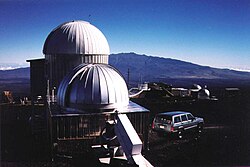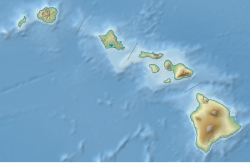 MLSO domes on Mauna Loa | |||||
| Alternative names | ATLAS Mauna Loa | ||||
|---|---|---|---|---|---|
| Organization | National Center for Atmospheric Research | ||||
| Location | Mauna Loa, Hawaii | ||||
| Coordinates | 19°32′10″N155°34′34″W / 19.536°N 155.576°W | ||||
| Altitude | 3,394 meters (11,135 ft) | ||||
| Established | 1965 | ||||
| Website | www2 | ||||
| Telescopes | |||||
| |||||
 | |||||
The Mauna Loa Solar Observatory (MLSO) is a solar observatory located on the slopes of Mauna Loa on the island of Hawai'i in the U.S. state of Hawaii. Built in 1965, the MLSO is operated by the High Altitude Observatory (HAO), a laboratory within the National Center for Atmospheric Research (NCAR), and is situated on property managed by the Mauna Loa Observatory. [1]
Contents
- Instruments
- Upgraded Coronal Multi-channel Polarimeter
- K-coronagraph
- Former instruments
- See also
- References
- External links
The MLSO is tasked with monitoring the Sun's atmosphere through observation of the chromosphere and corona. Studies of coronal mass ejections (CMEs) are also conducted at MLSO.
